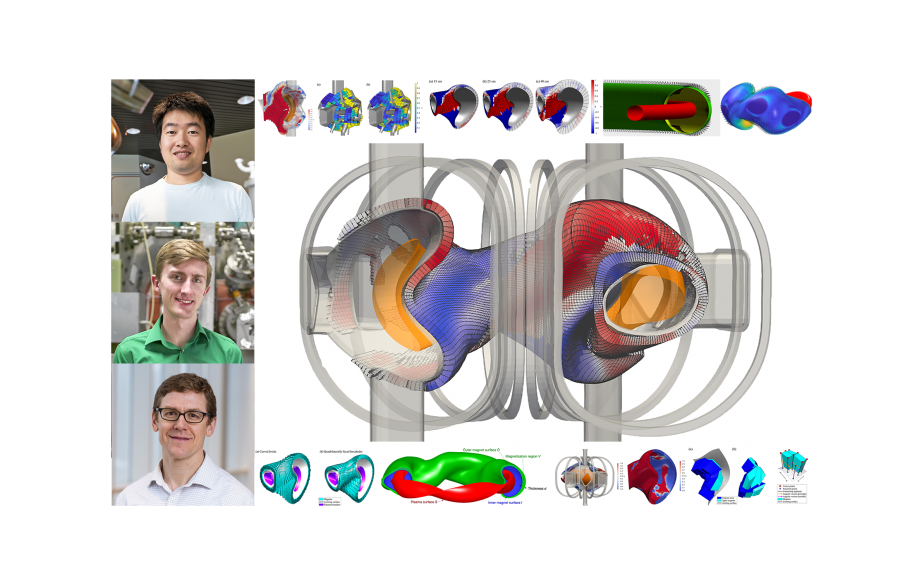“What we’ve done is added a new way to make magnetic fields,” said physicist David Gates, leader of the PPPL team that is developing the radical concept. “If we succeed, it’s the basis for a new stellarator that can be built without the massive investment in complex coils and can be set on the path to lower-cost fusion energy.” Originating the concept were Michael Zarnstorff, chief scientist at PPPL, Steve Cowley, director of PPPL, and Per Helander, who was visiting PPPL from the Max Planck Institute for Plasma Physics in Greifswald, Germany.
Could prove revolutionary
The use of permanent magnets could prove revolutionary, Cowley said. “If successful, application of the magnets could sharply reduce the cost and accelerate the arrival of fusion energy.”
Fusion, the power that drives the sun and stars, combines light elements in the form of plasma — the hot, charged state of matter composed of free electrons and atomic nuclei — that generates massive amounts of energy. Scientists around the world are using tokamaks, stellarators, and other facilities in the effort to reproduce fusion on Earth for a virtually inexhaustible supply of safe and clean power to generate electricity.
The Gates team has published three recent papers in the journal Nuclear Fusion that build on one another and lay the groundwork for permanent magnet stellerators. A fourth paper by a PPPL collaborator that the journal Plasma Physics and Controlled Fusion has accepted takes an alternative look at the main issues. The key concepts:
• Opening the door. This paper by PPPL physicist Caoxiang Zhu adapts an existing design method to quickly obtain an arrangement of permanent magnets that would be set perpendicular to the stellarator they are mounted on.
• Increased sophistication. Zhu’s second paper develops a numerical software tool to optimize the position and orientation of permanent magnets to generate the magnetic field. This method produces a more sophisticated model than the previous paper and a more feasible engineering design.
• Crafting the magnets. This paper by PPPL physicist Ken Hammond considers ways to cut magnets into shapes that engineers can work with. The findings generate input for the numerical tool mentioned above. Coauthors of this paper and the preceding one include PPPL engineers Tom Brown, Keith Corrigan and Marc Sibilia.
• Another method. A new paper by University of Maryland Physicist Matt Landreman demonstrates an alternative technique for arranging permanent magnets to control the plasma. The paper, with Zhu of PPPL as coauthor, takes a detailed look at where to place the magnets, how large they should be, and where they should be pointing.
The PPPL team now turns its attention to a three-year project to design and build the prototype for a section of a permanent magnet stellarator that will demonstrate the precise shaping of the fields the magnets can create. SABR Enterprises, a North Andover, Massachusetts, company that specializes in constructing permanent magnet assemblies, will develop the magnets in partnership with PPPL. (See funding story.) Assisting the design will be Auburn University, which has a small stellarator program of its own.
Complete stellarator
This three-year project could be followed by the design and construction of a complete permanent magnet stellarator. The facility could include components of the unfinished National Compact Stellarator Experiment (NSCX), whose construction PPPL discontinued in 2008 following cost overruns.
Also underway at the laboratory is construction of a small-scale tabletop stellarator with permanent magnets that a Princeton University graduate student is building with a PPPL engineer and a part-time Laboratory researcher. The aim of the tabletop device, which is being developed under the supervision of Chief Scientist Zarnstorff, is to demonstrate that permanent magnets can accurately create plasma-shaping fields.
For Gates, the successful development of his team’s project will demonstrate a simple method for creating stellarator magnetic fields. “We have a very specific idea of how our project will work out,” he said. “There are certain risks in doing things you’ve never done before and we want to eliminate those risks. We want to build this magnet and we think we can, and once we’ve done it we can turn to the next permanent magnet device.”
PPPL, on Princeton University’s Forrestal Campus in Plainsboro, N.J., is devoted to creating new knowledge about the physics of plasmas — ultra-hot, charged gases — and to developing practical solutions for the creation of fusion energy.The Laboratory is managed by the University for the DOE Office of Science, which is the single largest supporter of basic research in the physical sciences in the United States and is working to address some of the most pressing challenges of our time. For more information, visit energy.gov/science.




